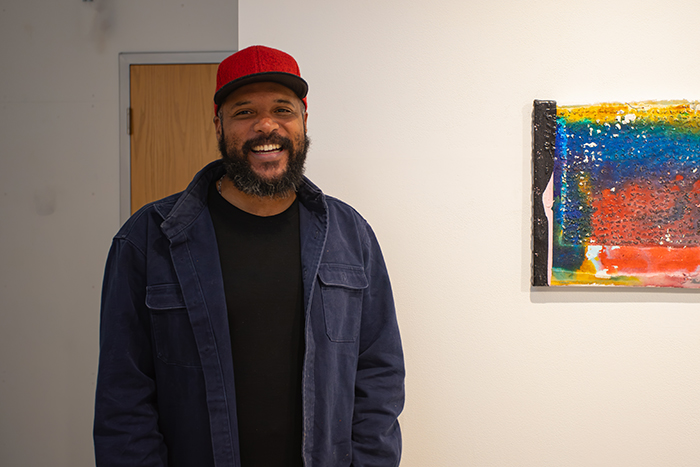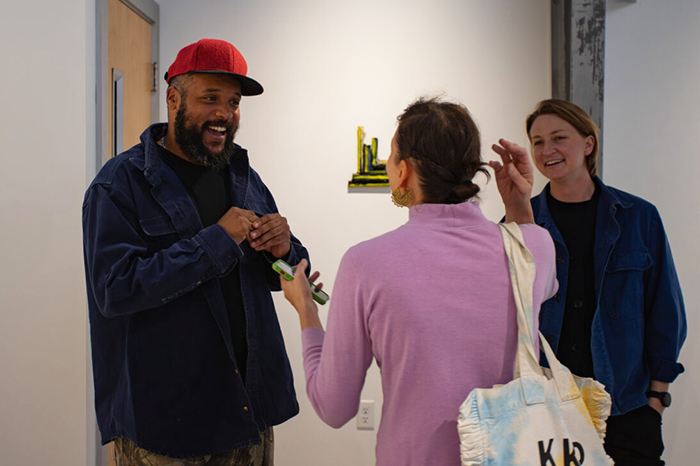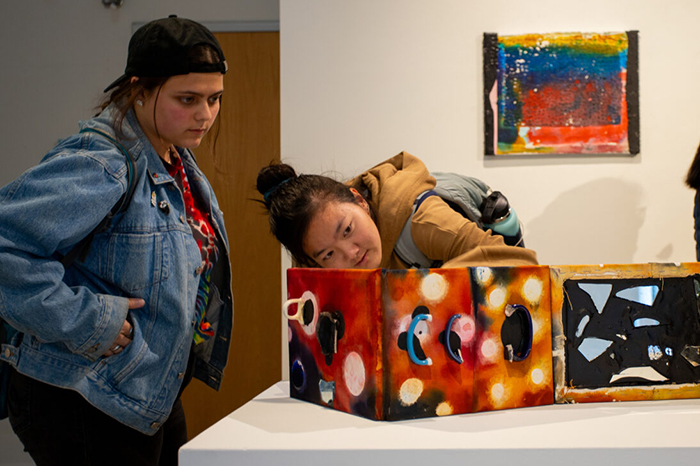Creating a Way Forward: Warith Taha’s Advice to Young Artists

Warith Taha's works explore Black and queer identity. Photo by Riley Heffron ’26.
Artist-in-residence shares insights on works, career
by MaryAlice Bitts-Jackson
Five weeks into his stay at Dickinson, Warith Taha pulled back the curtain on his success as a working artist and gave practical advice to students with similar goals. His public lecture, held Oct. 25, capped an artistic residency that included open-studio hours, classroom visits, individualized critiques for class of ’24 studio art majors and an exhibition in Goodyear Studio. (The exhibition of new and recent works remains on display in Goodyear Studio through Nov. 4.)
Taha came to Dickinson through the Sylvia J. Smith '73 Artist-in-Residence Program, bringing emerging and established professionals to campus to interact closely with students, create new work and share those works with the campus and local community. Taha is the 13th Sylvia Smith artist-in-residence to visit Dickinson. “His warmth, generosity and thoughtfulness has been a welcome addition to the Goodyear Gallery this fall,” says Eleanor Conover, assistant professor of art & art history, who coordinated Taha’s residency.

The artist-in-residence interacted with students and faculty throughout his time on campus. Photo by Riley Heffron ’26.
The artist earned a sociology degree at Boston College and lived abroad as a new graduate—experiences that broadened his view of himself and the world. A friendship with a professional artist inspired him to pour those perspectives into art and take the leap into a creative career. “The work I really vibe wjth is work that asks the big questions, and studying sociology exposed me to questions outside of the art realm, which I bring into my practice to this day,” he told the students, who gain like exposure through their liberal-arts coursework.
Taha went on to earn an MFA in painting from Tyler School of Art and Architecture in Philadelphia. Straight out of grad school, he was awarded the Headland Center for the Arts’ 2020-21 Tournesol Award and completed a yearlong residency. More opportunities, including a recent residency at the University of Tennessee, followed. Working primarily in painting and collage, Taha creates art as a means of resistance against historical erasure and inaccuracies, as he explores themes such as race, gender, sexuality and class. The hypervisibility—and, at times, invisibility—of Black and queer bodies in public spaces is a recurring theme.
Taha often incorporates personally meaningful objects and scans of those objects, such as family photos and elements of a loved one's clothing. In his lecture, he noted that growing up in the political and social-justice hotbed of the San Francisco Bay area left an indelible mark in his life and artistic practice. So too did the trauma of losing his mother to cancer when he was a boy. “A lot of my work is about memories and domestic family spaces,” Taha said, “and a lot of it asks the question: How do you hold things together when something, or someone, is missing?’ I feel like I’m still working through that loss.”

Students view Taha's work in the Goodyear Gallery. Photo by Riley Heffron ’26.
Speaking with students, Taha discussed his methods—among them, using a Xerox machine to scan 3-D objects, weaving representational elements together to create abstract forms, deploying mirrors to draw viewers in and affixing objects in paint or cement. He also offered advice, ranging from the broadly inspirational (“Art-making is hard work, but if you toil toward your goal, you’ll create a way forward,” “Not all artists are in a studio, in front of an easel—there are so many creative industries and so many ways of sustaining a practice”) to the highly specific (“Invest in good photography. It’s very hard for judges to see past a bad photo”).
The artist also seized the opportunity to thank his host. “The past few weeks have been a really welcoming time. I think I’ve made some jumps in my work, and it’s because of how comfortable you’ve made me feel,” he said. “I’m also thankful for the beautiful studio space you have here and the time to work, ask questions and reflect.”
Asked how he enjoyed working in the studio alongside students, he smiled. “I’m amazed by how thoughtful the students are as they ask and answer questions,” Taha said. “You’re thinking through some of the same questions that I was asking when I was a student.”
Learn about more public arts events through Dickinson's Calendar of Arts.
TAKE THE NEXT STEPS
Published October 27, 2023